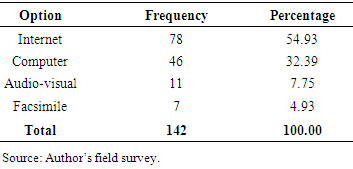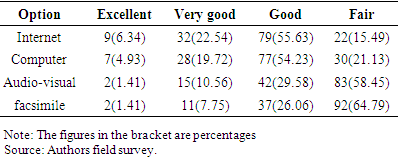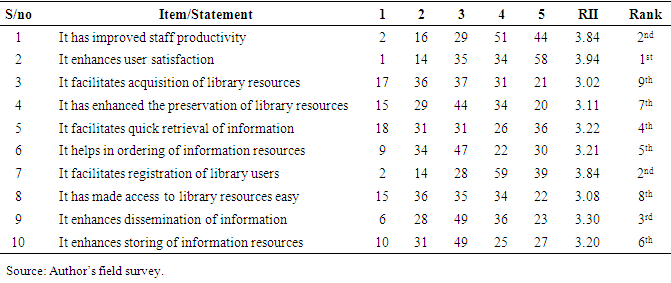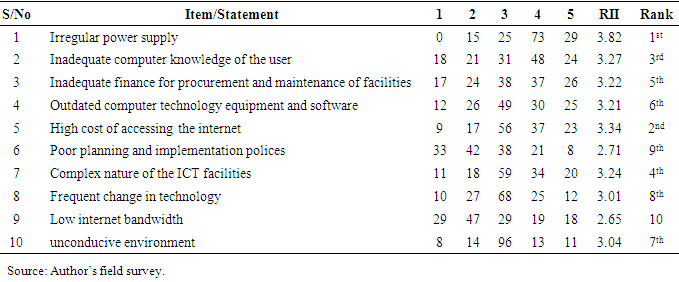-
Paper Information
- Paper Submission
-
Journal Information
- About This Journal
- Editorial Board
- Current Issue
- Archive
- Author Guidelines
- Contact Us
International Journal of Library Science
p-ISSN: 2168-488X e-ISSN: 2168-4901
2022; 10(1): 1-7
doi:10.5923/j.library.20221001.01
Received: Nov. 14, 2021; Accepted: Dec. 12, 2021; Published: Mar. 24, 2022

A Survey of Application of Information Technology in Nigerian Private University Library: A Case of Eastern Palm University, Imo State, Nigeria
Nkechi Priscilla Nwanekezie
Eastern Palm University, Ogboko, Ideato, Imo State, Nigeria
Correspondence to: Nkechi Priscilla Nwanekezie, Eastern Palm University, Ogboko, Ideato, Imo State, Nigeria.
| Email: |  |
Copyright © 2022 The Author(s). Published by Scientific & Academic Publishing.
This work is licensed under the Creative Commons Attribution International License (CC BY).
http://creativecommons.org/licenses/by/4.0/

This study surveyed the deployment of information technology in the library of eastern palm university (EPU), Imo State. Total enumeration survey of 178 registered users and 7 library staff were surveyed through questionnaire and 142 (76-75%) of the questionnaire were retrieved for analysis. Simple percentage and relative importance index were adopted to analyze the gathered data. The study found that information technology is being deployed at the university library and that majority of the users and staff are vested in the use of information technology facilities in the library. The study also found that the deployment of information technology in the library has enhanced user satisfaction, improved staff productivity, registration of library users and dissemination of information. The study among other things, suggested speedy completion, equipping and utilization of the new library and provision of alternative power supply such as solar power to mitigate the erratic public power supply to the library.
Keywords: Library, Information, Technology, Internet, Computer
Cite this paper: Nkechi Priscilla Nwanekezie, A Survey of Application of Information Technology in Nigerian Private University Library: A Case of Eastern Palm University, Imo State, Nigeria, International Journal of Library Science, Vol. 10 No. 1, 2022, pp. 1-7. doi: 10.5923/j.library.20221001.01.
Article Outline
1. Introduction
- The world today is often described as a global village because of the impact of technology. Technology has revolutionalized access to information such that with a tap of finger any information can be accessed. There is hardly any aspect of human endeavor that has not been impacted by the revolution in information technology. This revolution has affected the library. Gone are the days when library was just seen as a mere stockroom of knowledge. Information technology has re-organized library routines. Issa, Ayodele, Abubakar and Aliyu (2011) see information technology in libraries as comprising all the electronic infrastructure and facilities employed by libraries to improve and provide efficient services. The authors further opined that library should not merely store documents and preserve them; it must also devise means by which the contents of such documents can be rapidly and effectively transmitted for use.Ebunweke, Ola and Uduebor (2014) sees information technology in library as one where computer systems are used to manage one or several library routine systems such as acquisition, serial control, cataloguing and classification and the online public access catalogue. They divided information technology application in library into three categories of computer, storage media and telecommunications. Ubogu (2019) stated that information technology has changed the system of acquisition, technical processing and circulation activities in library, in a way that library patrons can gain access to their information requirement with no great efforts. This change is obvious in the adaptation of printed bibliographic sources into CD-Rom databases, direct access to distant database online and the copious move in information search strategies.Today library resources can be accessed from homes and offices through terminals. Thousands of monographic materials, journals, learning resources, and databases are now available in electronic formats, which can be accessed from any location. Khan (2016) enumerated the advantages of information technology in library to include making library work easier, faster, cheaper and more effective; helping to manage information overload as information retrieval is made easier in computerized systems; remote access is being enabled through networked systems; and saving of space and reduction of paper. While Krubi and Osawaru (2011) opined that the emergence of information technology in libraries has changed the role of library and information science professionals from intermediary to facilitator thereby creating new tools for dissemination of information and shift from physical to visual services environment. According to them this has resulted in the extinction of some conventional information services and emergence of new and innovative web based alternatives.The potential benefits of information technology in libraries as discussed above, are enormous but not without challenges. Issa et al (2011), Mkpojiogu and Udoma (2018) and Ubogu (2019) have discussed problems facing the use of information technology to include dearth of competent man power to handle all aspects of automation, poor funding, constant change of software and hardware, erratic power supply, insufficient bandwidth etc. Studies such as Ubogu (2019) have examined application of information technology in university libraries in south- south of Nigeria, Ezema and Gbushi (2019) in South-East Nigeria, Aba, Idoko and Ascor (2017) in north central, Nigeria, Issa et al. (2011) in Ondo State, and Kruba and Osawaru (2011) in Edo State. However little or no studies have been conducted in private universities in the south East, hence this study.
2. Review of Related Literature
- Several studies have been conducted on the application of information technology in university library. This section shall x-ray some of these studies with a view to identifying gaps and need for the present study.In a study of application of information technology to library services, Issa et al. (2011) in Akure used convenient sampling to survey two hundred and two (202) students of federal university of technology, Akure out of the total population of nine hundred and twenty nine (929) users of the library. Simple percentages were adopted to analyze the gathered data. The study found that information technology facilities such as internet, computer, audio-visual and fax were available in the library and majority of the respondents used internet and computer, while audio visual and fax facilities were not commonly used. The authors also found that information technology facilitates, lessens and/or hastens the work of the Librarian.The study further revealed that majority of the respondents encounter problems such as frequent power failure, network failures etc., in using information technology facilities in the library. The authors recommended increased library funding, alternative sources of power supply and training of students on the use of information technology facilities. The sampling technique is not probabilistic in nature and can not be a true representation of the population and its finding may not be generalized. Besides it was conducted in Akure, thus there is need for a corresponding study in another region.Krubu and Osawaru (2011) in Edo examined the impact of information and communication in Nigeria using John Harris Library and Benson Idahosa University Library. A total enumeration Survey of 49 staff of both libraries was conducted. Questionnaire was their main instrument of data collection and percentages were used to analyze the data. The study found that the Libraries were automated and strategic library automatic management (SLAM) was used. It also revealed that only three divisions of both university libraries were automated viz reader’s services, technical services and collection development divisions. The study found that automation has eased library operations and that inadequate funding, epileptic power supply, lack of search skills etc. are the major factors militating against the application of ICT in Nigerian University Libraries. The study then suggested more generous financial support of libraries and orientation programs on the use of computers. The findings of the study are quite relevant and need to be replicated elsewhere with a survey of not only the staff but also the students to arrive at a holistic result.In a non-empirical paper, Vijayakumar and Vijayan (2011) discussed the application of information technology in libraries. The authors listed areas of libraries where information technology is needed to include library management, library automation, library networking, audio-visual and technical communication. They also listed advantages of information technology in libraries to include easy combination of different library activities, collaboration and creation of library networks, saving the time of library users, increased efficiency, among others. The views and conclusions reached in this study can best be described as the author’s opinion since no survey was carried out.Dhanavandan and Tamizhchelvan (2014) in another non-empirical study examined the role of information technology in academic libraries. The paper highlighted challenges encountered in libraries to include expanding electronic information environment, development of information infrastructure, need for quality based services, digital preservation etc. According to the authors, the needed changes in academic libraries include changes in higher education, demands for accountability and assessment, digitization of unique library resources, growth of mobile devices and applications among others. The paper advocated for reorientation of librarians and acquisition of new skills using the new technology in the field of information science in academic libraries. Again, this paper is without survey and its findings and conclusions cannot be generalized. Ebunuwele, Ola and Uduebor (2014) in a non-empirical study, examined the application of information communication technology in academic libraries in Nigeria. The authors opined that ICT is useful in academic libraries in that it allows easy integration of various activities, it eliminates some uninteresting and repetitive work, it increases efficiency, it provides more up to date information etc. They suggested the criteria for automation of libraries to include repetitive routines, templates, calculations, file management activities, and user menus. The study can best be described as the author’s opinion since no field survey was conducted. Whong (2014) in Nigeria surveyed a cross-section of three hundred and thirty-six (336) library technical staff from six (6) federal universities in a study of information technology in libraries. The data was analyzed using descriptive and inferential statistics. The study revealed that books, newspapers, and magazines were the major types of library information resources available, while computers and internet facilities were the most available ICT facilities available for the management of library information resources. The study found that there was significant difference among the universities libraries studied in the type of ICT facilities available and used for the management of their library information resources. The findings in this study are quite relevant and more recent study will present the current position.Xiaoding (2015) in china examined application of computer technology in library resources management. The author reasoned that with advanced science and technology in place of human labor, the library resources management becomes more scientific, accurate, efficient, and effective to reduce problems of service quality caused by human errors in the process of library resources management. However, the applications of computers in library services are not without problems. These problems include the challenge of updating software and perfection of hardware, erratic power supply etc. In a similar study, Khan (2016) listed problems facing application of information technology in libraries to include poor funding of ICT infrastructures, constant change of software and hardware, erratic power supply, insufficient bandwidth, lack of technical IT knowledge by library staff, copyright and intellectual property rights management etc. However, no survey was carried out to arrive at the conclusions in both papers. In another non-empirical study, Shukla and Sialai (2016) examined the application of ICT tools and techniques in academic libraries. The paper examined the starting point of ICT application in Libraries and its history among world libraries. Relevant technologies under computer technology, communication technology, optical technology, multimedia technology etc. in libraries environment was also discussed. The authors concluded that due to wider application of ICT in libraries, library professionals’ roles have changed. This study is descriptive in nature, lacking any empirical survey and its conclusions are unverifiable. Aba, Idoka, and Akor (2017) studied application of computer technologies to reference services in university and research institute libraries in North central Nigeria. Total enumeration of 234 librarians was conducted and data collected were analyzed using frequency counts, percentages, mean and standard deviation. The study found that computer technologies was used to a little extent for reference services in university libraries, while in research institute libraries. It was highly used. It also found that the problem that hindered the application of computer technologies to reference services were irregular supply of power in university libraries. This study only examined the reference section of libraries without other sections. Thus there is need to examine other sections of the library and in other regions of the country.In a study of availability and utilization of information communication technologies facilities by students in libraries, Agim, Iroeze, Osuji and Obasi-Haco (2018) in Owerri, Imo State surveyed a cross section of 290 students of Federal Polytechnic Nekede, Owerri. Chi-square and percentages were used to analyze the gathered data. The study found that scanning machines, printers, CD-ROMs, computers, flash drives, land area network (LAN) and inverters were available but few. It also revealed that majority of the respondents use ICT to retrieve information, conduct research and download files. They further showed unreliable telecommunication network, insecurity in the library, epileptic power supply, high cost of ICT hardware and software as major challenges of availability and utilization of ICT in the library. The sample size was intuitively determined and therefore not completely acceptable.Ezema and Crbuushi (2019) in a study of Federal University libraries in South East Nigeria, examined the use of ICT facilities in collection development. Purposive sampling technique was adopted for the study and data were analyzed using mean and standard deviation. The study indicated that collection practitioners utilize some of the facilities to a high extent. It also revealed a significant difference in the mean response among the three sampled universities collection development practitioners on the extent to which ICT facilities are used in federal universities libraries in southeast Nigeria. The study concluded that university library management needs to provide an enabling environment for ICT facilities. The study failed to state the study population, and sample size; hence the data can be seen as the author’s fabrication which cannot be verified.Ubogu (2019) studied federal university libraries in south –south Nigeria. A total enumeration survey of 105 librarians in six (6) federal universities was conducted. Data were analyzed using frequency count and simple percentage. The study found that ICT are mostly used for acquisition and cataloging processes and circulation routines. It revealed that ICT facilities are used in the library because they are easier and faster and save the time of Librarians. The study also revealed that Librarians performance in ICTs skills is very low. The study advocated for training and retraining in ICT skills for librarians and increased funding of the Libraries. The study was conducted in public universities, hence there is need to conduct same in private universities to obtain a holistic view of application of information technology in university libraries.
3. Study Area
- Eastern palm university (EPU) is situated at Ogboko, Ideato south local government area of Imo state. It was founded in 2016 by the Imo state Government and managed by the Rochas foundation. It commenced academic activities in 2017/2018 academic session following recognition by the National University Commissionof Nigeria. Eastern palm university (EPU) has 14 (fourteen) programmes cutting across seven (7) schools. The library is presently housed in one building, while a much bigger, one–story building has been completed awaiting partitioning and furnishing. The current library has facilities such as tables, chairs, air conditioners, fans, lighting, audiovisuals, photo copying machines, printers, smart boards and one hundred (100) computers for the e- library section etc. The library has staff strength of seven (7) made up of the university Librarian, deputy university Librarian, reference Librarian, head of technical section and library assistant. It has also one hundred and seventy-eight (178) registered users as at December, 2020.
4. Research Methodology
- Registered users and staff at the eastern palm university constituted the study population. Available records at the library indicates that there are one hundred and seventy eight (178) registered users and seven (7) staff at the eastern palm university library, giving a total study population of one hundred and eighty five (185). Since the total population was not large, a total enumeration survey of the population was conducted to allow for equal opportunity in the survey. Closed-ended questionnaire was the main instrument of data collection. The questionnaires were administered on the respondents through personal contacts and assistance from some students and librarians. The researcher was able to retrieve one hundred and forty two (142) questionnaires representing 76.75% of the total population. The resultant data was analyzed and interpreted using simple percentages and relative importance index. The index is a 5 –point scale with the mean value of 3.00, thus any index that is less than the mean value is considered insignificant.
5. Data Presentation and Discussion
- This section presents data gathered through the administration of the questionnaire on the respondents. First the respondents were asked about the frequency of usage of available information technology facilities in the university library and table 1 below present their responses.
|
|
|
|
6. Conclusions and Recommendations
- This study examined the application of information technology in library of Eastern Palm University, Imo state. The study concluded that information technology is deployed at the university library and that majority of the students /staff used them often. The study also concluded that majority of the users of the university library are vested in the use of computer and the internet facilities. It is also the conclusion of this study that information technology in the university library has enhanced user satisfaction, improved staff productivity, registration of library users and dissemination of information. The study further concluded that irregular power supply, high cost of accessing the internet, user’s inadequate computer knowledge, complex nature of information technology facilities and inadequate finance for procurement and maintenance of facilities posed significant challenges/constraints to the application of information technology in the university library.The university management should ensure speedily equipping and utilizing the new library block to enhance users’ satisfaction and conducive environment for use of library resources. Provision of alternative power supply such as solar power will help to ameliorate the erratic nature of public power supply to the library and the high cost of fuel for the generators. Deliberate provision of funds for procurement and maintenance of facilities will help to cushion the deterioration of these facilities.
 Abstract
Abstract Reference
Reference Full-Text PDF
Full-Text PDF Full-text HTML
Full-text HTML


